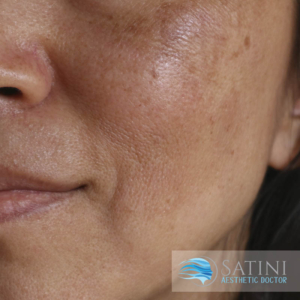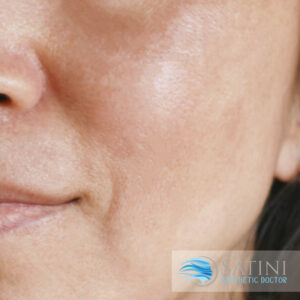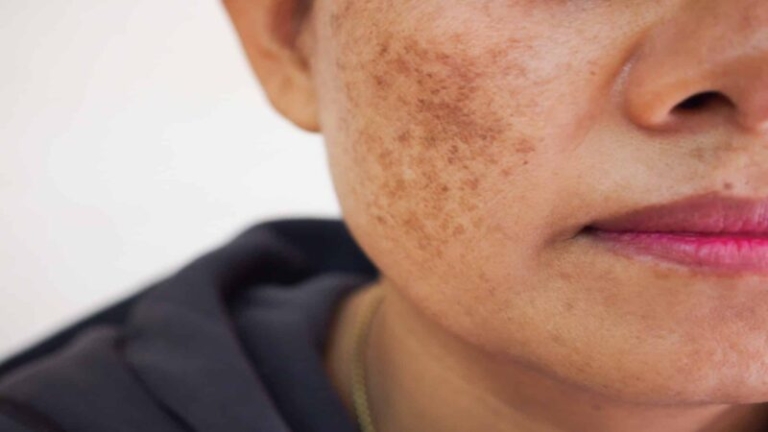Melasma Treatment in NZ-all you need to know
In NZ, melasma is a very common skin problem that affects mainly women in their 20s to 40s. It presents as brownish patches on the face, mainly on both sides. It is often triggered by hormonal changes such as pregnancy or starting the pill.
Our treatments can improve 60 to 80% of melasma and make it fade or disappear, but unfortunately, the risk of recurrence is quite high. Often, melasma comes back when your skin is exposed to the sun, even if it is just for a short moment.
Therefore, we recommend that you wear high-quality SPF 50+ sunscreen daily, even during winter, to prevent it from returning.
What is melasma?
Melasma is a skin condition that mainly affects women during their reproductive years. Studies have shown that as many as 8.8% to 40% of the female population suffers from melasma. The condition is more common in women with darker skin.
Melasma typically presents as smooth, brownish patches under your skin, mostly on both sides of your face. Some of your skin cells produce more of the brownish pigment melanin, causing the brownish colour change. Hormonal changes, such as starting the pill or pregnancy, usually trigger this process. But often, the doctor will not find a clear reason.
In NZ, several treatment options for melasma are available. Read more in our blog.
What makes melasma worse?
Melasma can worsen with sunlight, which increases melanin production and makes the dark patches more noticeable. Hormonal changes, such as pregnancy or hormone therapy, can also exacerbate melasma. Some medications, such as birth control pills, can cause or worsen melasma.
| Kligman Solution | Tranexamic Acid | Cosmelan/Dermamelan | Laser | Microneedling | |
|---|---|---|---|---|---|
| What is it? | Prescription Cream | Prescription Tablet | In-clinic mask plus at-home programme | One wavelength light | High speed needling of the skin |
| How effective is it? | ++++ | +++ | +++ | ++++ | ++ |
| PROS | Easy to apply
Affordable Highest success rates |
Works well for melasma
Proven in studies |
Rejuvenates the skin and treats melasma | Treats redness and uneven pigmentation | Easily tolerated
Quick office procedure Safe during pregnancy |
| CONS | It can cause redness and irritation
Overuse must be avoided It can cause blue discolouration of the skin in high amounts over a long time |
Can cause side effects
Not suitable for people with blood clotting disorders |
Expensive
You need to follow the programme for 4 to 7 months |
Expensive
It can sometimes require downtime |
Not that effective |
| Is it safe for dark skin? | Yes | Yes | Yes | 10-15% risk of new pigmentation | Yes |
What treatments work for melasma?
Research shows that a cream with hydroquinone, isotretinoin, and a steroid is most effective for treating melasma. In New Zealand, they call it the Kligman solution. If you apply it regularly over a period of 3 months, it can improve up to 89% of melasma. On top of that, the addition of a prescription medication called tranexamic acid further fades melasma.
We usually recommend starting these treatments first after ensuring you are medically safe. They have a high success rate, are affordable and easy to use. Despite that, melasma has a very high recurrence rate.
Kligman Solution
The Kligman Solution is a treatment for melasma. It combines hydroquinone, tretinoin, and a steroid to help lighten dark patches caused by this skin condition. Until today, this remains the gold standard and most effective treatment.
If you apply it regularly over a period of 3 months, it can improve up to 89% of melasma.
In New Zealand, a doctor has to prescribe this melasma treatment. Special pharmacies must compound it because it is not readily available at the chemist.
Tranexamic Acid
Tranexamic acid is a prescription drug that helps reduce melasma when used with other treatments. Doctors often give this medicine to lessen heavy periods, showing they believe it is safe to use. However, at this stage, the treatment of melasma is not FDA-approved.
While safe, you should avoid long-term regular use because of potential side effects. It can raise your risk of blood clots. This is especially true if a family member had Deep Vein Thrombosis or Pulmonary Embolism.
Cosmelan or Dermamelan Mask
The Cosmelan or Dermamelan Mask are advanced and intensive chemical peels that target several forms of pigmentation, including melasma. The doctor applies a mask in the clinic, and you then follow a three- to four-month programme.
The mask often works better if you have used a prescription cream for melasma for a few weeks before. This will damage the pigment in your skin and lead to enhanced results after the mask.
These masks combine plant ingredients and mild chemical peels to help lighten dark spots and create a more even skin tone.
Which treatments don’t work so well?
The above treatments are the first choice for melasma
IPL
(Intense Pulsed Light) treatments, which use light therapy to target pigmentation, are not as effective for treating melasma. IPL treatments are effective for dark spots, but a few studies suggest that they are not effective for melasma.
Laser
Laser treatment can help with melasma. However, seeing an experienced doctor who can help you choose the best type of laser for your skin is important. Laser treatment carries a 10% to 15% risk of causing more pigmentation in people with darker skin types.
Microneedling
Microneedling can help fade melasma but is often less effective than other treatment options.
Photos of a patient with melasma
These photos were taken with the help of a Wood lamp. This helps the doctor to see the deeper layers of the melasma in the skin.

How do I prevent melasma from recurring?
Melasma almost always comes back. Protecting your skin against the sun and avoiding hormonal contraception is important. If the melasma recurs, you can start using the prescription cream again.
Protect Your Skin Against The Sun
To prevent it, protect your skin from the sun. This means wearing sunscreen with a high SPF 50+ daily, even on cloudy days, and reapplying it every few hours.
Wearing a wide-brimmed hat and sunglasses can also help protect your skin from the sun’s harmful rays. Avoiding excessive sun exposure, especially during peak hours, can also reduce the risk of melasma coming back.
Avoid hormonal contraceptives
Many forms of contraception, such as the pill, Jadelle or DEPO injections, can trigger melasma. Consider other birth control options like the MIRENA, which has fewer hormones, or a copper IUD.
Maintenance Treatment
You can apply the Kligman Cream twice or thrice weekly as an ongoing treatment. Please only apply small amounts to your skin, as long-term use can cause side effects.
You can use the Kligman solution again when you see the melasma returning. Apply it daily for as long as the melasma takes to resolve, with a maximum of two to three months. Then, only use it two or three times per week or stop it.
Anti-pigmentation skincare
Certain skincare products can also help manage melasma. Use products with kojic acid, vitamin C, retinol, and niacinamide to lighten dark spots and enhance your skin tone.
Use gentle exfoliants like AHAs or BHAs in your skincare routine. They help increase cell turnover. This can improve the appearance of melasma.
How can I treat melasma during pregnancy?
During pregnancy, you should avoid hydroquinone because it poses a safety risk to the baby. You should also avoid creams that contain retinol. This means that you have only limited options during pregnancy. Even though it is not as effective, you can still try microneedling to try and fade the pigment.
Most pigmentation creams contain retinol, but you may want to choose a cream with bakuchiol instead. This plant-based ingredient resembles the effects of retinol. It increases cell turnover and helps fade pigmentation. You can also add creams containing Vitamin C and Vitamin B (niacinamide).
Check our bakuchiol-containing products and other safe skin care creams for pregnancy here:
Kligman Solution

A combination cream that contains hydroquinone, a steroid and Vitamin A remains the gold standard for treating melasma.
Tranexamic Acid

This is a prescription drug that fades melasma. Please make an appointment with Dr Nadja Haub to discuss this treatment option.
Cosmelan Peel

An in-clinic mask followed by 7 months in the clinic and an at-home treatment program that targets pigmentation and melasma.
Book An Appointment at Satini Cosmetic Clinic
We can provide personalized recommendations and ensure that you are using safe and effective products for treating melasma. Call us or book online if you want to speak to our doctor.
Check more information about Melasma treatment NZ here:
https://www.google.com/search?q=melasma&sca_esv=2f99265a69e47569&sca_upv=1&ei=-mS5ZsTPDrKQnesPo8_L0Qw&start=10&sa=N&sstk=AagrsujZoKVTVI_IjAjfReU3eIVFrRu9Dsp1iNvoQcukFW_m8pRRWfTMqCbglhtU2UtWYY0Dc7J32U7UYzLUXIQv00xImxiYB_CqaA&ved=2ahUKEwjEtK2opu6HAxUySGcHHaPnMsoQ8NMDegQIBhAW&biw=1536&bih=695&dpr=1.25
https://www.health.harvard.edu/blog/melasma-what-are-the-best-treatments-202207112776
Satini Aesthetic Clinic Results


Peel For Uneven Pigmentation
A woman who was concerned about uneven pigmentation, dark spots and freckles. After several peels her skin was more even, radiant and lifted.

